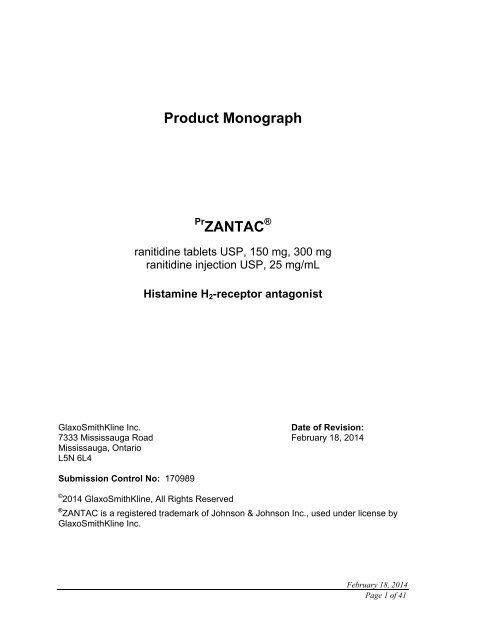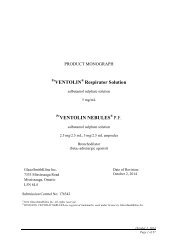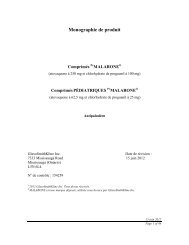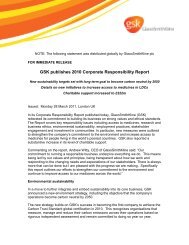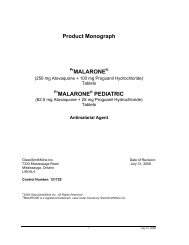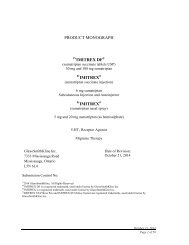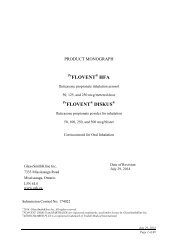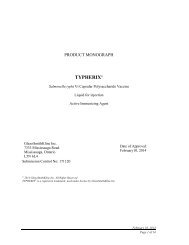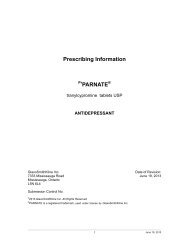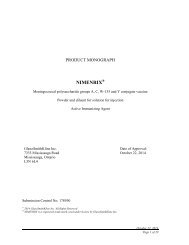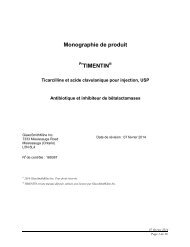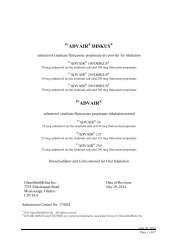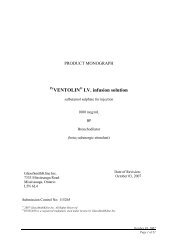Product Monograph ZANTAC - GlaxoSmithKline
Product Monograph ZANTAC - GlaxoSmithKline
Product Monograph ZANTAC - GlaxoSmithKline
- No tags were found...
You also want an ePaper? Increase the reach of your titles
YUMPU automatically turns print PDFs into web optimized ePapers that Google loves.
<strong>Product</strong> <strong>Monograph</strong>Pr <strong>ZANTAC</strong> ®ranitidine tablets USP, 150 mg, 300 mgranitidine injection USP, 25 mg/mLHistamine H 2 -receptor antagonist<strong>GlaxoSmithKline</strong> Inc.Date of Revision:7333 Mississauga Road February 18, 2014Mississauga, OntarioL5N 6L4Submission Control No: 170989© 2014 <strong>GlaxoSmithKline</strong>, All Rights Reserved® <strong>ZANTAC</strong> is a registered trademark of Johnson & Johnson Inc., used under license by<strong>GlaxoSmithKline</strong> Inc.February 18, 2014Page 1 of 41
<strong>Product</strong> <strong>Monograph</strong>Pr <strong>ZANTAC</strong> ®ranitidine tablets USP, 150 mg, 300 mgranitidine injection USP, 25 mg/mLHistamine H 2 -receptor antagonistACTIONS AND CLINICAL PHARMACOLOGYRanitidine is an antagonist of histamine at gastric H 2 -receptor sites. Thus, ranitidineinhibits both basal gastric secretion and gastric acid secretion induced by histamine,pentagastrin and other secretagogues. On a weight basis ranitidine is between 4 and9 times more potent than cimetidine. Inhibition of gastric acid secretion has beenobserved following intravenous, intraduodenal and oral administration of ranitidine. Thisresponse is dose-related, a maximum response being achieved at an oral dose of300 mg/day.Pepsin secretion is also inhibited but secretion of gastric mucus is not affected.Ranitidine does not alter the secretion of bicarbonate or enzymes from the pancreas inresponse to secretin and pancreozymin.Ranitidine is rapidly absorbed after oral administration of 150 mg ranitidine, peak plasmaconcentrations (300 to 550 ng/mL) occurred after 1 to 3 hours. Two distinct peaks or aplateau in the absorption phase result from reabsorption of drug excreted into theintestine. These plasma concentrations are not significantly influenced by the presenceof food in the stomach at the time of the oral administration nor by regular doses ofantacids.February 18, 2014Page 2 of 41
Bioavailability of oral ranitidine is approximately 50% to 60%. Serum protein binding ofranitidine in man is in the range of 10 to 19%. The elimination half-life is approximately 2to 3 hours. The principal route of excretion is the urine (40% recovery of free andmetabolized drug in 24 hours).There is a significant linear correlation between the dose administered and the inhibitoryeffect upon gastric acid secretion for oral doses up to 300 mg. A plasma ranitidineconcentration of 50 ng/mL has an inhibitory effect upon stimulated gastric acid secretionof approximately 50%. Estimates of the IC 50 range from 36 to 94 ng/mL. Following theadministration of 150 mg ranitidine orally, plasma concentrations in excess of this lastedfor more than 8 hours and after 12 hours, the plasma concentrations were sufficientlyhigh to have a significant inhibitory effect upon gastric secretion. In patients withduodenal ulcer, 150 mg oral ranitidine every 12 hours significantly reduced mean 24-hour hydrogen ion activity by 69% and nocturnal gastric acid output by 90%.Furthermore, 300 mg oral ranitidine at night is as effective in reducing 24-hourintragastric acidity as 150 mg ranitidine given orally twice daily.Following administration of 50 mg ranitidine injection intramuscularly, plasmaconcentrations in excess of 100 ng/mL were achieved within 5 minutes and remainedabove this level for 4 to 6 hours.Intravenous infusion (rate: 0.125 mg/kg/hour) produced a rise of intragastric pHbetween 5.6 and 7.0 after 2 hours and maintained this level over the 24 hour periodwhen administered to seriously ill patients. The volume of gastric secretion was reducedby more than 55%. Doubling the infusion rate to 0.25 mg/kg/hour produced no furtherincrease in gastric acid inhibition.A single 50 mg intravenous bolus dose of ranitidine injection produced significant acidinhibition 8 to 9 hours after administration. When 13 seriously ill patients with 2 or morerisk factors (shock, sepsis, respiratory failure, jaundice, renal insufficiency or peritonitis)were treated with a 50 mg intravenous bolus dose of ranitidine injection followed by acontinuous infusion of 0.2 mg/kg/hour, the number of 'at risk' days (gastric pH less than3.5 at 3 consecutive four-hour aliquots) was approximately half that of placebo treatedpatients.February 18, 2014Page 3 of 41
TabletsIn respect of both 24-hour acidity and nocturnal acid output, an oral dose of ranitidine150 mg twice daily was superior to cimetidine 200 mg three times daily and 400 mg atnight (p
Ranitidine injection is well tolerated following intravenous administration at dose levels ofup to 100 mg 4 times daily. It is evident that these levels are in excess of thoserecommended for normal clinical use.At 50 mg intravenously, ranitidine injection had no effect on prolactin levels. Only at the300 mg IV dose level was there an increase in prolactin secretion, which was equivalentto that produced by 200 mg of cimetidine administered intravenously.Patients over 50 years of ageIn patients over 50 years of age, half-life is prolonged (3 to 4 hours) and clearance isreduced, consistent with the age-related decline of renal function. However, systemicexposure and accumulation are 50% higher. This difference exceeds the effect ofdeclining renal function, and indicates increased bioavailability in older patients.INDICATIONS AND CLINICAL USE<strong>ZANTAC</strong> ® (ranitidine hydrochloride) Tablets and Injection are indicated for the treatmentof duodenal ulcer, benign gastric ulcer, reflux esophagitis, post-operative peptic ulcer,Zollinger-Ellison Syndrome, and other conditions where reduction of gastric secretionand acid output is desirable. These include the following:the treatment of nonsteroidal anti-inflammatory drug (NSAID)- induced lesions,both ulcers and erosions, and their gastrointestinal (GI) symptoms and theprevention of their recurrence;the prophylaxis of GI hemorrhage from stress ulceration in seriously ill patients;the prophylaxis of recurrent hemorrhage from bleeding ulcers;the prevention of Acid Aspiration Syndrome from general anaesthesia in patientsconsidered to be at risk for this, including obstetrical patients in labour, and obesepatients.February 18, 2014Page 5 of 41
In addition, <strong>ZANTAC</strong> ® is indicated for the prophylaxis and maintenance treatment ofduodenal or benign gastric ulcer in patients with a history of recurrent ulceration.CONTRAINDICATIONS<strong>ZANTAC</strong> ® (ranitidine hydrochloride) is contraindicated for patients known to havehypersensitivity to ranitidine or to any ingredient in the formulation. For a completelisting, see COMPOSITION.WARNINGSGastric UlcerTreatment with a histamine H 2 -antagonist may mask symptoms associated withcarcinoma of the stomach and, therefore, may delay diagnosis of that condition.Accordingly, where gastric ulcer is suspected the possibility of malignancy should beexcluded before therapy with <strong>ZANTAC</strong> ® (ranitidine hydrochloride) is instituted.Concomitant NSAID UseRegular supervision of patients who are taking non-steroidal anti-inflammatory drugsconcomitantly with <strong>ZANTAC</strong> ® is recommended especially in the elderly and in those witha history of peptic ulcer. Baseline endoscopy and histological evaluation is necessary torule out gastric carcinoma.Use in Patients with a History of Acute PorphyriaRare clinical reports suggest that ranitidine may precipitate acute porphyric attacks.Therefore, ranitidine should be avoided in patients with a history of acute porphyria.FertilityThere are no data on the effects of <strong>ZANTAC</strong> ® on human fertility. There were no effectson male and female fertility in animal studies (see TOXICOLOGY).February 18, 2014Page 6 of 41
Use in Pregnancy and Nursing MothersThe safety of <strong>ZANTAC</strong> ® in the treatment of conditions where a controlled reduction ofgastric secretion is required during pregnancy has not been established. Reproductionstudies performed in rats and rabbits have revealed no evidence of <strong>ZANTAC</strong> ® inducedimpaired fertility or harm to the fetus. Ranitidine crosses the placenta. Nevertheless, ifthe administration of <strong>ZANTAC</strong> ® is considered to be necessary, its use requires that thepotential benefits be weighed against possible hazards to the patient and to the fetus.<strong>ZANTAC</strong> ® is secreted in breast milk in lactating mothers but the clinical significance ofthis has not been fully evaluated. Like other drugs, <strong>ZANTAC</strong> ® should only be used duringnursing if considered essential.ChildrenExperience with <strong>ZANTAC</strong> ® products in children is limited. It has, however, been usedsuccessfully in children aged 8 to 18 years in oral doses up to 150 mg twice daily.PRECAUTIONSGeneralInjectionBradycardia in association with rapid administration of <strong>ZANTAC</strong> ® (ranitidinehydrochloride) Injection has been reported rarely, usually in patients with factorspredisposing to cardiac rhythm disturbances. Recommended rates of administrationshould not be exceeded. (See ADVERSE REACTIONS, DOSAGE ANDADMINISTRATION).The use of higher than recommended doses of IV H 2 -antagonists has been associatedwith rises in liver enzymes when treatment has been extended beyond five days.February 18, 2014Page 7 of 41
Use in Impaired Renal Function<strong>ZANTAC</strong> ® is excreted via the kidneys and, in the presence of renal impairment, plasmalevels of <strong>ZANTAC</strong> ® are increased and elimination prolonged. Accordingly, it isrecommended in such patients, to decrease the dosage of <strong>ZANTAC</strong> ® by one half.Accumulation of <strong>ZANTAC</strong> ® with resulting elevated plasma concentrations will occur inpatients with renal impairment (creatinine clearance less than 50 ml/min); arecommended daily dose of oral ranitidine in such patients should be 150 mg.Interaction with Other DrugsRanitidine has the potential to affect the absorption, metabolism or renal excretion ofother drugs. The altered pharmacokinetics may necessitate dosage adjustment of theaffected drug or discontinuation of treatment.Interactions occur by several mechanisms including:1) Inhibition of cytochrome P450-linked mixed function oxygenase system:Ranitidine at usual therapeutic doses does not potentiate the actions of drugs which areinactivated by this enzyme system such as diazepam, lidocaine, phenytoin, propranololand theophylline.There have been reports of altered prothrombin time with coumarin anticoagulants (e.g.warfarin). Due to the narrow therapeutic index, close monitoring of increased ordecreased prothrombin time is recommended during concurrent treatment withranitidine.February 18, 2014Page 8 of 41
2) Competition for renal tubular secretion:Since ranitidine is partially eliminated by the cationic system, it may affect the clearanceof other drugs eliminated by this route. High doses of ranitidine (e.g such as those usedin the treatment of Zollinger-Ellison syndrome) may reduce the excretion ofprocainamide and N-acetylprocainamide resulting in increased plasma levels of thesedrugs.3) Alteration of gastric pH:The bioavailability of certain drugs may be affected. This can result in either an increasein absorption (e.g. triazolam, midazolam) or a decrease in absorption (e.g. ketoconazole,atazanavir, delaviridine, gefitnib).Sporadic cases of drug interactions have been reported in elderly patients involving bothhypoglycaemic drugs and theophylline. The significance of these reports cannot bedetermined at present, as controlled clinical trials with theophylline and <strong>ZANTAC</strong> ® havenot shown interaction.If high doses (two grams) of sucralfate are coadministered with <strong>ZANTAC</strong> ® , theabsorption of <strong>ZANTAC</strong> ® may be reduced. This effect is not seen if sucralfate is taken atleast two hours after <strong>ZANTAC</strong> ® administration.Special PopulationsIn patients such as the elderly, persons with chronic lung disease, diabetes or theimmunocompromised, there may be an increased risk of developing community acquiredpneumonia. A large epidemiological study showed an increased risk of developingcommunity acquired pneumonia in current users of H 2 receptor antagonists versus thosewho had stopped treatment, with an observed adjusted relative risk increase of 1.63(95% CI, 1.07-2.48).February 18, 2014Page 9 of 41
Use in the ElderlySince malignancy is more common in the elderly, particular consideration must be givento this before therapy with <strong>ZANTAC</strong> ® is instituted. Elderly patients receiving nonsteroidalanti-inflammatory drugs concomitantly with <strong>ZANTAC</strong> ® should be closelysupervised.As with all medication in the elderly, when prescribing <strong>ZANTAC</strong> ® , consideration shouldbe given to the patient's concurrent drug therapy. Sporadic cases of drug interactionhave been reported in elderly patients involving both hypoglycaemic drugs andtheophylline. The significance of these reports cannot be determined at present, ascontrolled clinical trials with theophylline and <strong>ZANTAC</strong> ® have not shown interaction.Elderly patients may be at increased risk for confusional states and depression.ADVERSE REACTIONSTablets and InjectionThe following adverse reactions have been reported as events in clinical trials or in theroutine management of patients treated with <strong>ZANTAC</strong> ® (ranitidine hydrochloride). Acause and effect relationship to <strong>ZANTAC</strong> ® is not always established.Central Nervous SystemHeadache, sometimes severe; malaise; dizziness; somnolence; insomnia; vertigo; andreversible blurred vision suggestive of a change in accommodation. Isolated cases ofreversible mental confusion, agitation, depression, hallucinations have been reported,predominantly in severely ill elderly patients. In addition, reversible involuntarymovement disorders have been reported rarely.February 18, 2014Page 10 of 41
CardiovascularIsolated reports of tachycardia, bradycardia, premature ventricular beats, AV block havebeen noted. Asystole has been reported in very few individuals with and withoutpredisposing conditions following IV administration and has not been reported followingoral administration of <strong>ZANTAC</strong> ® (See PRECAUTIONS, DOSAGE ANDADMINISTRATION).GastrointestinalConstipation, diarrhea, nausea/vomiting and abdominal discomfort/pain.HepaticIn normal volunteers, transient and reversible SGPT and SGOT values were increasedto at least twice the pretreatment levels in 6 of 12 subjects receiving ranitidine 100 mgqid intravenously for seven days, and in 4 of 24 subjects receiving 50 mg qidintravenously for five days. Therefore, it may be prudent to monitor SGOT and SGPT inpatients receiving intravenous treatment for five days or longer and in those with preexistingliver diseases. With oral administration, there have been occasional reports ofhepatitis, hepatocellular or hepatocanalicular or mixed, with or without jaundice. In suchcircumstances, ranitidine should be discontinued immediately. These are usuallyreversible, but in exceedingly rare circumstances, death has occurred.RenalVery rare cases of acute interstitial nephritis have been reported.MusculoskeletalRare reports of arthralgia and myalgia.February 18, 2014Page 11 of 41
HaematologicBlood count changes (leukopenia, thrombocytopenia) have occurred in a few patients.These are usually reversible. Rare cases of agranulocytosis or pancytopenia,sometimes with marrow hypoplasia or aplasia have been reported.EndocrineNo clinically significant interference with endocrine or gonadal function has beenreported. There have been a few reports of breast symptoms and breast conditions(such as gynaecomastia and galactorrhoea).DermatologicRash, including cases suggestive of mild erythema multiforme. Rare cases of vasculitisand alopecia have been reported.OtherRare cases of hypersensitivity reactions (including chest pain, bronchospasm, fever,rash, eosinophilia, anaphylaxis, urticaria, angioneurotic edema, hypotension) and smallincreases in serum creatinine have occasionally occurred after a single dose. Acutepancreatitis and reversible impotence has been reported rarely.SYMPTOMS AND TREATMENT OF OVERDOSAGEThere is no experience to date with deliberate overdosage. The usual measures toremove unabsorbed drug from the gastrointestinal tract (including activated charcoal orsyrup of ipecac), clinical monitoring and supportive therapy should be employed.For management of a suspected drug overdose, contact your regional PoisonControl Centre.February 18, 2014Page 12 of 41
DOSAGE AND ADMINISTRATIONTablet AdministrationDuodenal ulcer or benign gastric ulcer300 mg once daily at bedtime or 150 mg twice daily taken in the morning and beforeretiring. It is not necessary to time the dose in relation to meals. In most cases ofduodenal ulcer and benign gastric ulcer, healing will occur in four weeks. In the smallnumber of patients whose ulcers may not have fully healed, these are likely to respondto a further four week course of therapy. In the treatment of duodenal ulcers, 300 mgtwice daily for 4 weeks may be of benefit when more rapid healing is desired.Maintenance therapyDuodenal ulcers, benign gastric ulcers: Patients who have responded to short-termtherapy, particularly those with a history of recurrent ulcer, may benefit from chronicmaintenance therapy at a reduced oral dosage of 150 mg once daily at bedtime.In the management of duodenal ulcers, smoking is associated with a higher rate of ulcerrelapse (up to 9.2 times higher in one trial), and such patients should be advised to stopsmoking. In those patients who fail to comply with such advice, 300 mg nightly providesadditional therapeutic benefit over the 150 mg once daily dosage regimen.Reflux esophagitisAcute treatment300 mg once daily at bedtime, or alternatively 150 mg twice daily, taken in the morningand before retiring for up to eight weeks. In patients with moderate to severeesophagitis, the dosage of ranitidine may be increased to 150 mg four times daily for upto 12 weeks.February 18, 2014Page 13 of 41
Long-term ManagementFor the long-term management of reflux esophagitis, the recommended adult oral doseis 150 mg twice daily.Post-operative peptic ulcer150 mg twice daily, taken in the morning and before retiring.Pathological hypersecretory conditions (Zollinger-Ellison Syndrome)150 mg three times daily may be administered initially. In some patients, it may benecessary to administer <strong>ZANTAC</strong> ® 150 mg doses more frequently. Doses should beadjusted to individual patient needs. Doses up to six grams per day have been welltolerated.Treatment of NSAID-induced lesions (both ulcers and erosions) and theirgastrointestinal symptoms and prevention of their recurrenceIn ulcers following non-steroidal anti-inflammatory drug therapy or associated withcontinued non-steroidal anti-inflammatory drugs, 150 mg twice daily for 8-12 weeks maybe necessary. For the prevention of non-steroidal anti-inflammatory drug associatedulcer recurrence, 150 mg twice daily may be given concomitantly with non-steroidal antiinflammatorydrug therapy.Prophylaxis of acid aspiration syndrome (AAS)150 mg the evening prior to anaesthesia induction is recommended, however, 150 mgtwo hours before anaesthesia induction is also effective. Alternatively, <strong>ZANTAC</strong> ®Injection may be used. For the prevention of AAS in pre-partum patients who elect foranaesthesia, 150 mg every six hours may be employed, but if general anaesthesia iswarranted, a non-particulate oral antacid (for example, sodium citrate) could supplement<strong>ZANTAC</strong> ® therapy. In an emergency situation, the use of alkalis, antacids, andmeticulous anaesthetic technique is still necessary as <strong>ZANTAC</strong> ® does not affect the pHand volume of the existing gastric content.February 18, 2014Page 14 of 41
Prophylaxis of hemorrhage from stress ulceration in seriously ill patients orprophylaxis of recurrent hemorrhage in patients bleeding from peptic ulcerationwho are currently managed by intravenous <strong>ZANTAC</strong> ®An oral dose of 150 mg twice daily may be substituted for the injection once oral feedingcommences.Dosage for the ElderlyFor all conditions listed above, the drug dosage for the elderly who are seriously illshould start at the lowest recommended dose and be adjusted as necessary with closesupervision.Patients over 50 years of age (see ACTIONS AND CLINICAL PHARMACOLOGY,Patients over 50 years of age).Parenteral AdministrationIn some hospitalized patients with pathological hypersecretory conditions or intractableduodenal ulcers, or in patients unable to take oral medication, <strong>ZANTAC</strong> ® may beadministered parenterally according to the following recommendations:Intramuscular Injection50 mg (2 mL) every six to eight hours (no dilution is required).Intravenous Injection50 mg (2 mL) every six to eight hours. Dilute <strong>ZANTAC</strong> ® Injection, 50 mg in compatibleIV solution (see PHARMACEUTICAL INFORMATION, Dilution of Parenteral <strong>Product</strong>s) toa total volume of 20 mL and inject over a period of not less than five minutes (SeePRECAUTIONS). Parenteral administration may continue until oral feeding iscommenced and, if there is still a risk, oral <strong>ZANTAC</strong> ® may then commence.Intermittent Intravenous Infusion50 mg (2 mL) every six to eight hours. Dilute <strong>ZANTAC</strong> ® Injection 50 mg in 100 mL ofcompatible IV solution (see PHARMACEUTICAL INFORMATION, Dilution of Parenteral<strong>Product</strong>s) and infuse over 15 to 20 minutes. In some patients, it may be necessary toFebruary 18, 2014Page 15 of 41
increase dosage. When this is required, the increases should be made by morefrequent administration of a 50 mg dose, but generally should not exceed 400 mg perday.In the prophylaxis of upper gastrointestinal hemorrhage from stress ulceration inseriously ill patients, a primary dose of 50 mg as a slow (over a period of not less thanfive minutes) intravenous injection followed by a continuous intravenous infusion of0.125 - 0.250 mg/kg/hr may be preferred (See PRECAUTIONS). The higher infusionconcentration (0.25 mg/kg/hr) should be reserved for patients who are unresponsive to alower concentration (0.125 mg/kg/hr).In the prophylaxis of hemorrhage from stress ulceration in seriously ill patients orprophylaxis of recurrent hemorrhage in patients bleeding from peptic ulceration,parenteral administration may continue until oral feeding is commenced and if there isstill a risk, oral <strong>ZANTAC</strong> ® may then commence.For patients considered at risk of developing acid aspiration syndrome (Mendelson'sSyndrome), 50 mg by intramuscular or slow (over a period of not less than 5 minutes)intravenous injection 45 to 60 minutes before induction of general anaesthesia. In anemergency situation, the use of alkalis, antacids, and meticulous anaesthetic techniqueis still necessary as <strong>ZANTAC</strong> ® does not affect the pH and volume of the existing gastriccontent.February 18, 2014Page 16 of 41
PHARMACEUTICAL INFORMATIONDrug SubstanceProper Name:ranitidine hydrochlorideChemical Name:N-{2-[({5-[(dimethylamino)-methyl]-2-furanyl} methyl)thio]ethyl}-N’-methyl-2-nitro-1, 1-ethenediamine, hydrochlorideStructural Formula:CHNO 2CH 3CH 3NNS NCH 3 HOH. HCIMolecular Formula:C 13 H 22 N 4 O 3 S•HClMolecular Weight:350.87 (as hydrochloride salt)Description:Ranitidine hydrochloride is a white to pale yellow granularsubstance. At room temperature, ranitidine hydrochloride issoluble in water, methanol, ethanol and chloroform (decreasingorder). <strong>ZANTAC</strong> ® Injection is a clear, colourless to light yellowliquid. The pH of the injection solution is 6.7 to 7.3.February 18, 2014Page 17 of 41
COMPOSITION<strong>ZANTAC</strong> ® Tablets150 mg Each tablet contains 168 mg of ranitidine hydrochloride (150 mg ranitidineanhydrous free base). Tablets also contain the following excipients:microcrystalline cellulose and magnesium stearate. The film-coatingsuspension contains the following excipients: hydroxypropylmethylcellulose, triacetin, and titanium dioxide.300 mg Each tablet contains 336 mg of ranitidine hydrochloride (300 mg ranitidineanhydrous free base). Tablets also contain the following excipients:microcrystalline cellulose, croscarmellose sodium, and magnesiumstearate. The film-coating suspension contains the following excipients:hydroxypropyl methylcellulose, triacetin, and titanium dioxide.<strong>ZANTAC</strong> ® InjectionEach mL contains 28 mg ranitidine hydrochloride equivalent to 25 mg ranitidineanhydrous free base in Sterile Water for Injection for intravenous or intramuscularadministration. Non-medicinal ingredients include phenol (5 mg/mL) as a preservative,disodium hydrogen orthophosphate (2.4 mg/mL), and potassium dihydrogenorthophosphate (0.96 mg/mL).STORAGE AND STABILITY<strong>ZANTAC</strong> ® TabletsStore between 2°C and 30°C. Protect from light.<strong>ZANTAC</strong> ® InjectionStore between 2°C and 25°C. Protect from light.<strong>ZANTAC</strong> ® Injection should not be autoclaved.February 18, 2014Page 18 of 41
Dilution of Parenteral <strong>Product</strong>sIntramuscular InjectionNo dilution is required.Intravenous Injection<strong>ZANTAC</strong> ® Injection for intravenous injection should be diluted to 20 mL(2.5 mg/mL) with one of the recommended diluents listed below.Intermittent Intravenous Infusion<strong>ZANTAC</strong> ® Injection for intermittent intravenous infusion should be diluted to 100 mL(0.5 mg/mL) with one of the recommended diluents listed below. <strong>ZANTAC</strong> ® Injection iscompatible in polyvinyl chloride infusion bags and in glass with the following intravenousfluids:0.9% sodium chloride5% dextrose0.18% sodium chloride and 4% dextrose4.2% sodium bicarbonateHartmann's solutionAdmixtures of <strong>ZANTAC</strong> ® Injection with 0.18% sodium chloride and 4% dextrose or 4.2%sodium bicarbonate or Hartmann's solution should be discarded after 24 hours.Although intravenous admixtures of <strong>ZANTAC</strong> ® Injection with 5% dextrose or 0.9%sodium chloride may often be physically and chemically stable for longer periods, due tomicrobiological considerations, they are usually recommended for use within themaximum of 72 hours when refrigerated (2° to 8°C) followed by 24 hours at roomtemperature.Hospitals and institutions that have recognized admixture programs and use validatedaseptic techniques for preparation of intravenous solutions, may extend the storage timefor <strong>ZANTAC</strong> ® Injection in admixture with 5% Dextrose Injection or 0.9% Sodium ChlorideFebruary 18, 2014Page 19 of 41
Injection in polyvinyl chloride infusion bags, in concentrations of up to 2 mg/mL, to35 days when stored under refrigeration at 2° to 8°C.Note: As with all parenteral drug products, intravenous admixtures should be inspectedvisually for clarity, particulate matter, precipitate, discolouration and leakage priorto administration, whenever solution and container permit. Solutions showinghaziness, particulate matter, precipitate, or discolouration or leakage should notbe used.Pharmaceutical Precautions<strong>ZANTAC</strong> ® Injection<strong>ZANTAC</strong> ® Injection should not be autoclaved.February 18, 2014Page 20 of 41
AVAILABILITY OF DOSAGE FORMS<strong>ZANTAC</strong> ® Tablets150 mg White, round, biconvex, film-coated tablets engraved <strong>ZANTAC</strong> 150 onone face and GLAXO on the other, available in foil packs of 60 tabletsand bottles of 100 and 500 tablets.300 mg White, capsule-shaped film-coated tablets engraved <strong>ZANTAC</strong> 300 on oneface and GLAXO on the other, available in foil packs of 30 tablets andbottles of 60 tablets.<strong>ZANTAC</strong> ® Injection<strong>ZANTAC</strong> ® Injection is available in 2 mL unit dose colourless glass vials in packs of 10and 40 mL multidose colourless glass vials in packs of 1.PHARMACOLOGYAnimal PharmacologyRanitidine is a potent competitive reversible, selective antagonist of histamine at H 2 -receptors in vitro and in vivo. Thus, ranitidine antagonised the actions of histamine atH 2 -receptors in the rat isolated uterus and in the guinea pig isolated atrium. Ranitidine isnot an anticholinergic agent. On a molar basis, ranitidine is 4 to 5 times more activethan cimetidine with a pA 2 value of 7.2. In concentrations 1,000 times greater than thoserequired to block H 2 -receptors, it failed to block either H 1 -receptors or muscarinicreceptors in the guinea pig isolated ileum. The beta-adrenoceptor responses of the ratuterus and guinea pig atrium to isoprenaline were also unaffected by ranitidine.Blockade of histamine H 2 -receptors in the stomach in vivo is the pharmacological actionof ranitidine with greatest immediate clinical relevance. Ranitidine inhibits gastricsecretion induced by various secretagogues in both the rat and dog.February 18, 2014Page 21 of 41
In the conscious dog with a Heidenhain pouch, ranitidine given orally or intravenouslyantagonised gastric acid secretion induced by histamine, pentagastrin and bethanechol.Ranitidine was 5 to 10 times more active than cimetidine. However, both ranitidine andcimetidine had similar time curves of action. Ranitidine also inhibited the gastricsecretory response to food in the conscious fistulated dog.Ranitidine inhibited acid secretion in the perfused stomach of the anaesthetised rat, andacetylsalicylic acid-induced gastric lesion formation in the conscious rat, both in thepresence and absence of excess hydrochloric acid. Measurements of the ratio ofmucosal blood flow to acid secretion show that the inhibitory action of ranitidine upongastric acid secretion cannot be attributed to changes in blood flow.There were no behavioural effects in the mouse and rat after oral administration of800 mg/kg ranitidine. Cats and dogs dosed with ranitidine 80 mg/kg orally, exhibited nobehavioural effects indicative of an action on the central nervous system, although at thishigh dose level in the dog there was an indication of peripheral vasodilation and skinirritation due to released histamine. Ranitidine, when coadministered with the followingCNS modulating preparations; codeine, hexobarbitone, ethyl alcohol, chlordiazepoxide,chlorpromazine, imipramine, α-methyldopa, reserpine, apomorphine orpentylenetetrazol, did not alter the pharmacological effects of either preparation.At a dose level 45 times the antisecretory ED 50 , intravenous infusion of ranitidine had noeffect on the heart rate, blood pressure or electrocardiogram of the anaesthetised dog.The respiratory system was unaffected by ranitidine after oral doses in the mouse, rat,rabbit, cat and dog and after intravenous doses in the dog.In the conscious dog, ranitidine had no appreciable effect on blood pressure or heartrate when administered orally at 10 mg/kg. There were short-lived falls in diastolic bloodpressure after an intravenous dose of 10 mg/kg, 370 times the antisecretory dose level.There was no evidence of arrhythmia nor of any electrocardiographic abnormality.Long-term toxicity studies have shown that ranitidine does not possess antiandrogenicactivity nor does it displace dihydrotestosterone from the androgen binding sites.February 18, 2014Page 22 of 41
In the dog up to 70% of the administered dose was excreted in the first 24 hours. About40% of the drug was excreted in the urine as unchanged ranitidine and up to 30% as theN-oxide, N-oxidation being the main route of metabolism of ranitidine in the dog. The N-oxide was also the major radioactive component present in dog bile together with smallamounts of unchanged ranitidine and FRM.In the rat, rabbit and dog, less than 10.1% of ranitidine in plasma is protein bound.Within one to seven days of administration of radio-labelled drug in the rat and dog over99% of the radioactivity was cleared from the body. In common with many drugs,radioactivity persisted in the uveal tract of these two species, the half-life in the doguveal tract being of the order of 6 months. Ranitidine and its S-oxide have greateraffinity for melanin than the desmethyl metabolite; the N-oxide is bound only to a smallextent.The placental transfer of radioactive ranitidine and its metabolites has been studied inthe pregnant rat and rabbit. Whole body autoradiography of rat and rabbit fetusesshowed that small amounts of radioactivity were present in the uveal tract of the fetaleye in both species, in the gall bladder and intestine of the rabbit fetus and in the bladderof the rat fetus. Radioactivity was also detected in the salivary and mammary glands ofthe maternal rat and at very low concentration, in the milk.Human PharmacokineticsSerum concentrations necessary to inhibit 50% of stimulated gastric acid secretion areestimated to be 36 to 94 ng/mL. Following a single oral dose of 150 mg, serumconcentrations of ranitidine are in this range for up to 12 hours. There is a relationshipbetween plasma concentrations of ranitidine and suppression of gastric acid productionbut wide interindividual variability exists.Ranitidine is 50% absorbed after oral administration compared to an IV injection withmean peak levels of 440 to 545 ng/mL occurring two to three hours after a 150 mg dose.The elimination half-life is 2 to 3 hours.The major route of elimination is renal. After IV administration of 150 mg 3H-ranitidine,98% of the dose was recovered, including 5% in feces and 93% in urine, of which 70%February 18, 2014Page 24 of 41
was unchanged parent drug. After oral administration of 150 mg 3-H ranitidine, 96% ofthe dose was recovered, 26% in the feces and 70% in urine of which 35% wasunchanged parent drug. Less than 3% of the dose is excreted in bile. Renal clearance isapproximately 500 mL/min, which exceeds glomerular filtration indicating net renaltubular secretion.Ranitidine is absorbed very rapidly after an intramuscular injection. Mean peak levels of576 ng/mL occur within 15 minutes or less following a 50 mg intramuscular dose.Absorption from intramuscular sites is virtually complete, with a bioavailability of 90% to100% compared with intravenous administration.The principal route of excretion is the urine, with approximately 30% of the orallyadministereddose collected in the urine as unchanged drug in 24 hours. Renalclearance is about 530 mL/min, indicating active tubular excretion, with a total clearanceof 760 mL/min. The volume of distribution ranges from 96 to 142 L.Studies in patients with hepatic dysfunction (compensated cirrhosis) indicate that thereare minor, but clinically insignificant alterations in ranitidine half-life, distribution,clearance and bioavailability.Serum protein binding averages 15%.The gastric antisecretory activity of ranitidine metabolites has been examined. In man,both the principal metabolite in the urine, the N-oxide (4% of the dose) and the S-oxide(1%) possess weak H 2 -receptor blocking activity but desmethylranitidine (1%) is only4 times less potent than ranitidine in the rat and half as potent as ranitidine in the dog.CLINICAL TRIALSIn 6 clinical trials examining the healing of duodenal ulcers in 1,500 patients, a dose of300 mg daily for 4 weeks was found to have an 83% healing rate; however, increasingthe dose to 300 mg twice daily gave significantly better results (92% healed at 4 weeks;p
TOXICOLOGYToxicology, Impairment of Fertility, Carcinogenesis, and MutagenesisRanitidine hydrochloride has been subjected to exhaustive toxicological testing whichhas demonstrated the lack of any specific target organ or any special risk associatedwith its clinical use.Non-clinical data revealed no special hazard for humans based on conventionalstudies of safety pharmacology, repeated-dose toxicity, genotoxicity, carcinogenicpotential and toxicity to reproduction and development.Acute Toxicity StudiesIn mice and rats, the intravenous LD 50 is of the order of 75 mg/kg, whereas orally,even doses of 1,000 mg/kg are not lethal. In dogs, the oral minimum lethal dose is450 mg/kg/day. High single doses of ranitidine (up to 80 mg/kg orally) show onlyminimal and reversible signs of toxicity, some of which are related to transitoryhistamine releases.Long-Term Toxicity StudiesIn the long-term toxicity and carcinogenicity studies, very high doses of ranitidinewere given daily to mice (up to 2000 mg/kg/day) throughout their normal life-span,and to dogs (up to 450 mg/kg/day) for periods of up to one year.These doses produced massive plasma ranitidine concentrations far in excess ofthose found in human patients receiving ranitidine at the recommended therapeuticdose. For example, in the dogs, peak plasma concentrations were in excess of115 µg/mL and in mice basal plasma levels were in the range of 4-9 µg/mL. In man,after oral administration of 150 mg ranitidine, the mean peak plasma concentration(C max ) was between 360 and 650 ng/mL.In the rat, doses as high as 2,000 mg/kg/day were well tolerated, the onlymorphological change seen was the increased incidence of accumulations of foamyFebruary 18, 2014Page 26 of 41
alveolar macrophages in the lungs. The accumulations of these cells is a naturalphenomena in aging rats and chronic administration of a wide variety of drugs hasbeen known to contribute to this process. Therefore, it is unlikely that thepharmacologic concentrations of ranitidine administered to these rats contributed tothis natural process.In the six-week and six-month oral studies in the dog (100 mg/kg/day) loose feceswere occasionally detected, while in the six-month study loose stools wereaccompanied on eight occasions by mucus-like material and sometimes by blood,mostly from one dog. Loose feces, salivation and vomiting were observed in the 54-week dog study.In isolated cases, dogs passed red-stained feces which occasionally tested positivefor occult blood. When the dose level was increased from 100 mg/kg/day to 225 –450 mg/kg/day, no further red-stained feces were seen, suggesting that anyrelationship to ranitidine is unlikely. Post-mortem examination of the dogs revealedno ranitidine-induced changes in the alimentary tract.One dog had marginally raised levels of plasma alanine aminotransferase andalkaline phosphatase during the six-week study. This same dog also showed somenecrotic foci in the liver. Small lesions of focal necrosis and fibrosis were also seenin one piece of liver from one female dog treated with 100 mg/kg for six months. Noother differences were detected by light and electron microscopic examination of thetreated and control livers. Since the focal lesions were seen in only one dog andwere restricted to one piece of liver, it suggests that they were not caused byranitidine.Muscular tremors, an inability to stand, and rapid respiration were seen on occasionin dogs treated with 225 mg/kg/day in the 54-week study. The prevalence of theseobservations was increased when the dose was increased to a toxic level of450 mg/kg/day. One dog died: no specific pathological changes or reason for thedeath was discovered.February 18, 2014Page 27 of 41
Changes in the colour or granularity of the tapetum lucidum of the eye were detectedin three dogs receiving the highest dose of ranitidine (450 mg/kg/day) during the 54-week study. In one dog this change was considered to be related to treatment. Thechange, a pallor of the tapetum, was reversible. No changes were seen with light orelectron microscopic examination of the eye. The changes in the tapetum are of noclinical significance in humans since (i) humans do not have a tapetum lucidum and(ii) the changes were only seen at toxic pharmacological concentrations of ranitidine.The mean serum glutamic pyruvic transaminase values for dogs treated at450 mg/kg/day were significantly greater, albeit marginally, than the control values.These enzyme increases were not accompanied by any histological changes.Studies in which ranitidine was administered parenterally were performed. No signof specific local irritation attributable to ranitidine was detected. In the rat, nobiochemical or histopathological changes were observed at intravenous dose levelsas high as 20 mg/kg. Specifically, no significant changes were found in the veins orsubcutis. Mild lesions in some muscle samples were observed: usually, the cellswere basophilic and smaller than normal; and the nuclei were swollen, morenumerous, and sometimes had migrated to the centre of the cell.In the rabbit, slight infiltration of the pannicular muscle by mononuclear cells werenoted. This minor subcutaneous reaction was uncommon and showed no grouprelated distribution. There was no apparent difference in irritance between ranitidineinjection and placebo injection. In the rat, intravenous ranitidine at dose levels of 5.0and 10.0 mg/kg daily for 15 days and 28 days produced no treatment relatedchanges of biological importance in the hematopoietic system.February 18, 2014Page 28 of 41
Rabbits receiving a bolus intravenous injection of ranitidine (10 mg/kg) once daily ongestation days 7-16 exhibited a reduction in weight gain. Their fetuses weighedsignificantly less than fetuses of untreated controls. In addition, 12.4% of ranitidineexposedfetuses had cleft palates. Reanalysis of this and a companion studyperformed to assess reproducibility demonstrated a lack of data reproducibility.Therefore, the effects observed in the first trial are aberrant, and should not form thebasis for maternal or fetal toxicity.In the subsequent study, no evidence of maternal or fetal toxicity was observed inrabbits dosed with 100 mg/kg ranitidine orally during days 2-29 of pregnancy. Thepeak plasma levels of ranitidine after a 100 mg/kg oral dose are similar to thoseobtained one minute after a 10 mg/kg dose administered intravenously (20-25 µg/mL). Therefore, no teratogenic effects of ranitidine have been demonstratedat doses of 10 mg/kg (IV) and 100 mg/kg (Tablets) in rabbits.Carcinogenicity StudiesThere is no evidence that ranitidine is a carcinogen. Long term toxicity andcarcinogenicity studies have involved the treatment of 600 mice and 636 rats atdoses up to 2,000 mg/kg for two years and 129 weeks respectively and 42 dogs atdoses up to 450 mg/kg/day for periods up to one year. These dose levels are far inexcess of those to be used therapeutically in man. None of these animals had anyintestinal metaplasia. There was no evidence of a tumourigenic effect of ranitidine inany other tissue.MutagenesisRanitidine is not mutagenic at doses as great as 30 mg/plate in the Ames Assayutilizing Salmonella typhimurium (TA 1538, TA 98, TA 100 and TA 1537) or in dosesof 9 mg/plate utilizing Escherichia coli (WP2 and WP2 uvrA) with or withoutactivation.Ranitidine at concentrations of 20-30 mg/plate had a weak direct mutagenic action inS. typhimurium TA 1535 and at 9 mg/plate in E. coli WP67. <strong>ZANTAC</strong> ® was notmutagenic at a concentration of 2 mg/mL in E. coli or S. typhimurium in the moreFebruary 18, 2014Page 30 of 41
sensitive Oral Solution microtitre fluctuation assay method. This weak directmutagenic effect is of no clinical significance; the magnitudes of ranitidineconcentration used in these assays are thousands of times greater than that attainedtherapeutically in human plasma.The principal metabolites of ranitidine in man were not significantly mutagenic. Thisconclusion is supported by the following experiment. A test solution obtained byinteracting ranitidine (10 mM) and sodium nitrite (40mM) was mutagenic inS. typhimurium (TA 1535) but not in S. typhimurium (TA 1537) or in E. coli (WP67 orWP2 uvrA). This positive result is attributable to the presence of a nitrosonitrolic acidderivative AH 23729, which was mutagenic. When the sodium nitrite concentrationwas reduced to 15 mM or less, the solution was not mutagenic in any of the testmicroorganisms. The formation of AH 23729 requires concentrations of nitrous acidfar in excess of those encountered in any probable physiological conditions. Theother nitrosation products were not mutagenic in any of the microorganisms tested.There is no reason, therefore, for supposing that ranitidine is likely to be mutagenicin animals or man as a consequence of nitrosation in the stomach.There is no evidence from long term toxicology, carcinogenicity and mutagenicitystudies in animals to suggest that ranitidine is likely to have any deleterious effects inman when administered at therapeutic dose levels.February 18, 2014Page 31 of 41
Selected Bibliography1. Ashton MG, Holdsworth CD, Ryan FP, Moore M. Healing of gastric ulcers afterone, two, and three months of ranitidine. Br Med J (Clin Res Ed) 1982;284(6314):467-468.2. Bell JA, Dallas FA, Jenner WN, Martin LE. The metabolism of ranitidine inanimals and man [proceedings]. Biochem Soc Trans 1980; 8(1):93.3. Bories P, Michel H, Duclos B, Beraud JJ, Mirouze J. Use of ranitidine, withoutmental confusion, in patients with renal failure. Lancet 1980; 2(8197):755.4. Boyd EJ, Wilson JA, Wormsley KG. Review of ulcer treatment: role of ranitidine.J Clin Gastroenterol 1983; 5 Suppl 1:133-141.5. Breen KJ, Bury R, Desmond PV, Mashford ML, Morphett B, Westwood B et al.Effects of cimetidine and ranitidine on hepatic drug metabolism. Clin PharmacolTher 1982; 31(3):297-300.6. Brogden RN, Carmine AA, Heel RC, Speight TM, Avery GS. Ranitidine: a reviewof its pharmacology and therapeutic use in peptic ulcer disease and other allieddiseases. Drugs 1982; 24(4):267-303.7. Critchlow JF. Comparative efficacy of parenteral histamine (H 2 )-antagonists inacid suppression for the prevention of stress ulceration. Am J Med 1987;83(6A):23-28.8. Dammann HG, Muller P, Simon B. Parenteral ranitidine: onset and duration ofaction. Br J Anaesth 1982; 54(11):1235-1236.9. Danilewitz M, Tim LO, Hirschowitz B. Ranitidine suppression of gastrichypersecretion resistant to cimetidine. N Engl J Med 1982; 306(1):20-22.10. Domschke W, Lux G, Domschke S. Furan H 2 -antagonist ranitidine inhibitspentagastrin-stimulated gastric secretion stronger than cimetidine.Gastroenterology 1980; 79(6):1267-1271.11. Durrant JM, Strunin L. Comparative trial of the effect of ranitidine and cimetidineon gastric secretion in fasting patients at induction of anaesthesia. Can AnaesthSoc J 1982; 29(5):446-451.February 18, 2014Page 32 of 41
12. Ehsanullah RSB, Page MC, Tildesley G, Wood JR. A placebo-controlled study ofranitidine in healing NSAID-associated gastric and duodenal ulcers. BritishSociety for Rheumatology, Seventh Annual General Meeting, London, 26-28September 1990.13. Freston JW. H 2 -receptor antagonists and duodenal ulcer recurrence: analysis ofefficacy and commentary on safety, costs, and patient selection. Am JGastroenterol 1987; 82(12):1242-1249.14. Gaginella TS, Bauman JH. Ranitidine hydrochloride. Drug Intell Clin Pharm 1983;17(12):873-885.15. Goudsouzian NG, Young ET. The efficacy of ranitidine in children. ActaAnaesthesiol Scand 1987; 31(5):387-390.16. Halparin L, Ruedy J. Inhibition of pentagastrin-stimulated gastric acid secretionby ranitidine hydrochloride and cimetidine. Current Therapeutic Research 1980;28(2):154-162.17. Harris PW, Morison DH, Dunn GL, Fargas-Babjak AM, Moudgil GC, SmedstadKG et al. Intramuscular cimetidine and ranitidine as prophylaxis against gastricaspiration syndrome--a randomized double-blind study. Can Anaesth Soc J1984; 31(6):599-603.18. Jensen RT, Collen MJ, Pandol SJ, Allende HD, Raufman JP, Bissonnette BM etal. Cimetidine-induced impotence and breast changes in patients with gastrichypersecretory states. N Engl J Med 1983; 308(15):883-887.19. Knodell RG, Holtzman JL, Crankshaw DL, Steele NM, Stanley LN. Drugmetabolism by rat and human hepatic microsomes in response to interaction withH 2 -receptor antagonists. Gastroenterology 1982; 82(1):84-88.20. Konturek SJ, Obtulowicz W, Kwiecien N, Sito E, Mikos E, Oleksy J. Comparisonof ranitidine and cimetidine in the inhibition of histamine, sham-feeding, andmeal-induced gastric secretion in duodenal ulcer patients. Gut 1980; 21(3):181-186.21. Lancaster-Smith MJ, Jaderberg ME, Jackson DA. Ranitidine in the treatment ofnon-steroidal anti-inflammatory drug associated gastric and duodenal ulcers. Gut1991; 32(3):252-255.February 18, 2014Page 33 of 41
22. Lebert PA, Mahon WA, MacLeod SM, Soldin SJ, Fenje P, Vandenberghe HM.Ranitidine kinetics and dynamics. II. Intravenous dose studies and comparisonwith cimetidine. Clin Pharmacol Ther 1981; 30(4):545-550.23. Leeder JS, Tesoro AM, Bertho-Gebara CE, MacLeod SM. Comparativebioavailability of ranitidine tablets and suspension. Canadian Journal of HospitalPharmacy 1984; 37(3):92-94, 106.24. Maile CJ, Francis RN. Pre-operative ranitidine. Effect of a single intravenousdose on pH and volume of gastric aspirate. Anaesthesia 1983; 38(4):324-326.25. Misiewicz JJ, Sewing K, editors. Proceedings of the First InternationalSymposium on Ranitidine. Scand J Gastroenterol 1981; 16(Suppl. 69): 1-131.26. Misiewicz JJ, Wormsley KG, editors. The clinical use of ranitidine : proceedingsof the Second International Symposium on Ranitidine held at the BarbicanCentre, London, UK, October 1981. 2nd International Symposium on Ranitidine;1981; London, England. Oxford [Oxfordshire]: Medicine Publishing Foundation;1982.27. Nelis GF, Van de Meene JG. Comparative effect of cimetidine and ranitidine onprolactin secretion. Postgrad Med J 1980; 56(657):478-480.28. Page M, Lacey L. Ranitidine syrup in the treatment of duodenal ulcer. AmericanJournal of Gastroenterology. 1987; 82(9),977.29. Pasquali R, Corinaldesi R, Miglioli M, Melchionda N, Capelli M, Barbara L. Effectof prolonged administration of ranitidine on pituitary and thyroid hormones, andtheir response to specific hypothalamic-releasing factors. Clin Endocrinol (Oxf)1981; 15(5):457-462.30. Peden NR, Robertson AJ, Boyd EJ, Brown RA, Gibbs JH, Potts RC et al.Mitogen stimulation of peripheral blood lymphocytes of duodenal ulcer patientsduring treatment with cimetidine or ranitidine. Gut 1982; 23(5):398-403.31. Riley AJ, Salmon PR, editors. Ranitidine : proceedings of an internationalsymposium held in the context of the Seventh World Congress ofGastroenterology, Stockholm, 17th June 1982. 3rd International Symposium onRanitidine and 7th World Congress of Gastroenterology; 1982; Stockholm,Sweden. Amsterdam: Excerpta Medica; 1982.32. Roberts CJ. Clinical pharmacokinetics of ranitidine. Clin Pharmacokinet 1984;9(3):211-221.February 18, 2014Page 34 of 41
33. Scarpignato C, Bertaccini G, Zimbaro G, Vitulo F. Ranitidine delays gastricemptying of solids in man. Br J Clin Pharmacol 1982; 13(2):252-253.34. Wolfe MM. Considerations for selection of parenteral histamine (H 2 )-receptorantagonists. Am J Med 1987; 83(6A):82-88.35. Yeomans ND, Hanson RG, Smallwood RA, Mihaly GW, Louis WJ. Effect ofchronic ranitidine treatment on secretion of intrinsic factor. Br Med J (Clin ResEd) 1982; 285(6337):264.February 18, 2014Page 35 of 41
IMPORTANT: PLEASE READPART III: CONSUMER INFORMATIONPr <strong>ZANTAC</strong> ®ranitidine tabletsThis leaflet is part III of a "<strong>Product</strong> <strong>Monograph</strong>" publishedwhen <strong>ZANTAC</strong> ® was approved for sale in Canada and isdesigned specifically for Consumers. This leaflet is asummary and will not tell you everything about <strong>ZANTAC</strong> ® .Contact your doctor or pharmacist if you have any questionsabout the drug.ABOUT THIS MEDICATIONWhat the medication is used for:• to heal ulcers in the stomach, or the part that it emptiesinto (the duodenum).• to prevent stomach ulcers which may be caused bymedicines called non-steroidal anti-inflammatory drugs(NSAIDs), often used to treat arthritis• to prevent ulcers from bleeding• to heal or stop problems caused by acid in the food pipe(esophagus) or too much acid in the stomach. This cancause pain or discomfort sometimes known asindigestion or heartburn• to stop acid coming up from the stomach while underanaesthetic during an operationWhat it does:<strong>ZANTAC</strong> ® belongs to a group of medicines called H 2 -receptor blockers. It works by reducing the amount of acidin your stomach.When it should not be used:Don’t take <strong>ZANTAC</strong> ® if you are allergic (hypersensitive) toranitidine or any other ingredients of <strong>ZANTAC</strong> ® (see Whatthe nonmedicinal ingredients are).What the medicinal ingredient is:ranitidine hydrochlorideWhat the nonmedicinal ingredients are:<strong>ZANTAC</strong> ® 150 mgTabletsThe non-medicinal ingredients are microcrystallinecellulose, and magnesium stearate. The film-coatingsuspension contains the following excipients:hydroxypropyl methylcellulose, triacetin, and titaniumdioxide.excipients: hydroxypropyl methylcellulose, triacetin, andtitanium dioxide.What dosage forms it comes in:Each tablet contains either 150 mg or 300 mg ranitidine (asranitidine hydrochloride).WARNINGS AND PRECAUTIONSBEFORE you use <strong>ZANTAC</strong> ® talk to your doctor orpharmacist if you:• have stomach cancer• have kidney disease, your doctor may lower your dose of<strong>ZANTAC</strong> ®• have a rare condition called acute porphyria (a blooddisease)• have lung disease• are diabetic• have any problems with your immune system• have had stomach ulcers before and you are taking Non-Steroidal Anti-Inflammatory (NSAID) medicines• are pregnant, planning to become pregnant, breastfeedingor planning to breastfeed• are taking any other medications including NSAIDs (seeInteractions with this Medication).INTERACTIONS WITH THIS MEDICATIONTell your doctor or pharmacist if you're taking any othermedicines, if you’ve taken any recently, or if you starttaking new ones. This includes medicines bought without aprescription. Some medicines can affect how <strong>ZANTAC</strong> ®works, or make it more likely that you’ll have side effects.<strong>ZANTAC</strong> ® can also affect how some other medicines work.Drugs that may interact with <strong>ZANTAC</strong> ® include:• procainamide or n-acetylprocainamide (used to treatheart problems)• warfarin (used to thin the blood)• triazolam (used to treat insomnia)• midazolam (a sedative that may be given just before anoperation)• ketoconazole (used to treat fungal infections)• atazanavir or delaviridine (used to treat HIV)• gefitnib (used to treat lung cancer)• Non-Steroidal Anti-Inflammatory (NSAID) medicines(used to treat pain and inflammation)• sucralfate (used to treat ulcers)<strong>ZANTAC</strong> ® 300 mgTabletsThe non-medicinal ingredients are microcrystallinecellulose, croscarmellose sodium, and magnesium stearate.The film-coating suspension contains the followingFebruary 18, 2014Page 36 of 41
IMPORTANT: PLEASE READPROPER USE OF THIS MEDICATIONUsual Adult Dose:Always take <strong>ZANTAC</strong> ® exactly as your doctor has told youto. Check with your doctor or pharmacist if you're not sure.The usual dose is either:• 150 mg in the morning and 150 mg in the evening or,• 300 mg at bedtimeYour exact dose will depend on your particular stomachcondition. Your doctor will tell you the dose you shouldtake.Swallow each tablet whole with some water.Overdose:If you take too much <strong>ZANTAC</strong> ® , contact your doctor orpharmacist for advice. If possible, show them the<strong>ZANTAC</strong> ® pack.In case of drug overdose, contact a health care practitioner,hospital emergency department or regional Poison ControlCentre immediately, even if there are no symptoms.SIDE EFFECTS AND WHAT TO DO ABOUT THEMSide effects may include:• allergic reactions• skin rash• inflammation of blood vessels (vasculitis)• inflammation of the pancreas (pancreatitis)• inflammation of the liver (hepatitis), sometimes withyellowing of the whites of the eyes or skin (jaundice)• inflammation in the kidney (interstitial nephritis)• slow, fast or irregular heartbeat• diarrhea, constipation, nausea, vomiting, stomach pain• feeling confused, depressed, or excited, or seeing orhearing things that are not really there (hallucinations),trouble sleeping (insomnia); feeling sleepy (somnolence)• joint or muscle pain, malaise, uncontrolled movement• headache, dizziness, blurred vision• unusual hair loss or thinning (alopecia)• unable to get or maintain an erection (impotence)• unusual secretion of breast milk or breast enlargement inmen• decrease in number of blood platelets (cells that helpblood to clot)• decrease in number of all types of blood cells• small increase in the level of creatinine (a waste product)in your bloodSERIOUS SIDE EFFECTS, HOW OFTEN THEYHAPPEN AND WHAT TO DO ABOUT THEMSymptom / effectRareVeryRareHypersensitivityReaction raisedand itchy rash(hives),swelling,sometimes ofthe face ormouth(angioedema),chest pain,shortness ofbreath,unexplainedfever, wheezingor difficulty inbreathing,feeling faint,especially whenstanding up,collapseSerious SkinReactionsSkin rash, whichmay blister, andlook like smalltargets (centraldark spotssurrounded by apaler area, witha dark ringaround theedge)Talk with yourdoctor orpharmacistOnly ifsevereIn allcasesStoptakingdrug andcall yourdoctor orpharmacistIf you have any concerns about the side effects, tell yourdoctor, nurse or pharmacist.Side effects that may show up in your blood tests:• changes to liver function• low levels of white blood cellsFebruary 18, 2014Page 37 of 41
IMPORTANT: PLEASE READSERIOUS SIDE EFFECTS, HOW OFTEN THEYHAPPEN AND WHAT TO DO ABOUT THEMSymptom / effectVeryRareVeryRareHepatitisYellowing ofthe skin orwhites of theeyes, dark or teacoloured urine,pale colouredstools/ bowelmovements,nausea/vomiting, lossof appetite,pain, aching ortenderness onright side belowthe ribsCardiovascularSlow, fast orirregularheartbeatTalk with yourdoctor orpharmacistOnly ifsevereIn allcasesStoptakingdrug andcall yourdoctor orpharmacistThis is not a complete list of side effects. For anyunexpected effects while taking <strong>ZANTAC</strong> ® , contact yourdoctor or pharmacist.HOW TO STORE ITStore <strong>ZANTAC</strong> ® Tablets between 2°C and 30°C. Protectfrom light. Keep out of reach of children.REPORTING SUSPECTED SIDE EFFECTSYou can report any suspected adverse reactions associatedwith the use of health products to the Canada VigilanceProgram by one of the following 3 ways:--------------------------------------------------------------------------Report online at www.healthcanada.gc.ca/medeffectCall toll-free at 1-866-234-2345Complete a Canada Vigilance Reporting Form and:- Fax toll-free to 1-866-678-6789, or- Mail to: Canada Vigilance ProgramHealth CanadaPostal Locator 0701EOttawa, OntarioK1A 0K9Postage paid labels, Canada Vigilance ReportingForm and the adverse reaction reporting guidelinesare available on the MedEffect Canada Web site atwww.healthcanada.gc.ca/medeffect.NOTE: Should you require information related to themanagement of side effects, contact your health professional.The Canada Vigilance Program does not provide medical advice.MORE INFORMATIONThis document plus the full product monograph, preparedfor health professionals can be found at:http://www.gsk.ca or by contacting the sponsor,<strong>GlaxoSmithKline</strong> Inc.7333 Mississauga RoadMississauga, OntarioL5N 6L41-800-387-7374This leaflet was prepared by <strong>GlaxoSmithKline</strong> Inc.Last revised: February 18, 2014© 2014 <strong>GlaxoSmithKline</strong> Inc. All Rights Reserved® <strong>ZANTAC</strong> is a registered trade-mark of Johnson & Johnson Inc.,used under license by <strong>GlaxoSmithKline</strong> Inc.February 18, 2014Page 38 of 41
IMPORTANT: PLEASE READPART III: CONSUMER INFORMATIONPr <strong>ZANTAC</strong> ®ranitidine injectionThis leaflet is part III of a "<strong>Product</strong> <strong>Monograph</strong>" publishedwhen <strong>ZANTAC</strong> ® was approved for sale in Canada and isdesigned specifically for Consumers. This leaflet is asummary and will not tell you everything about <strong>ZANTAC</strong> ® .Contact your doctor or pharmacist if you have any questionsabout the drug.ABOUT THIS MEDICATIONWhat the medication is used for:• to heal ulcers in the stomach, or the part that it emptiesinto (the duodenum).• to prevent stomach ulcers which may be caused bymedicines called non-steroidal anti-inflammatory drugs(NSAIDs), often used to treat arthritis• to prevent ulcers from bleeding• to heal or stop problems caused by acid in the food pipe(esophagus) or too much acid in the stomach. This cancause pain or discomfort sometimes known asindigestion or heartburn• to stop acid coming up from the stomach while underanaesthetic during an operationWhat it does:<strong>ZANTAC</strong> ® belongs to a group of medicines called H 2 -receptorblockers. It works by reducing the amount of acidin your stomach.When it should not be used:Don’t take <strong>ZANTAC</strong> ® if you are allergic (hypersensitive) toranitidine or any other ingredients of <strong>ZANTAC</strong> ® (see Whatthe nonmedicinal ingredients are).What the medicinal ingredient is:ranitidine hydrochlorideWhat the nonmedicinal ingredients are:Non-medicinal ingredients include phenol (as apreservative), disodium hydrogen orthophosphate, andpotassium dihydrogen orthophosphate.What dosage forms it comes in:Each ampoule contains 50 mg ranitidine (as ranitidinehydrochloride) in 2 ml aqueous solution (25 mg/ml).WARNINGS AND PRECAUTIONSBEFORE you use <strong>ZANTAC</strong> ® talk to your doctor orpharmacist if you:• have stomach cancer• have kidney disease, your doctor may lower your dose of<strong>ZANTAC</strong> ®• have a rare condition called acute porphyria (a blooddisease)• have lung disease• are diabetic• have any problems with your immune system• have a history of heart problems• have had stomach ulcers before and you are taking Non-Steroidal Anti-Inflammatory (NSAID) medicines• are pregnant, planning to become pregnant, breastfeedingor planning to breastfeed• are taking any other medications including NSAIDs (seeInteractions with this Medication).INTERACTIONS WITH THIS MEDICATIONTell your doctor or pharmacist if you're taking any othermedicines, if you’ve taken any recently, or if you starttaking new ones. This includes medicines bought without aprescription. Some medicines can affect how <strong>ZANTAC</strong> ®works, or make it more likely that you’ll have side effects.<strong>ZANTAC</strong> ® can also affect how some other medicines work.Drugs that may interact with <strong>ZANTAC</strong> ® include:• procainamide or n-acetylprocainamide (used to treatheart problems)• warfarin (used to thin the blood)• triazolam (used to treat insomnia)• midazolam (a sedative that may be given just before anoperation)• ketoconazole (used to treat fungal infections)• atazanavir or delaviridine (used to treat HIV)• gefitnib (used to treat lung cancer)• Non-Steroidal Anti-Inflammatory (NSAID) medicines(used to treat pain and inflammation)PROPER USE OF THIS MEDICATION<strong>ZANTAC</strong> ® injection is not self administered by anindividual. It should be administered under the supervisionof a health professional.Usual Adult Dose:The usual dose is 50 mg every 6 to 8 hours, as a singleinjection into a muscle.Alternatively, different doses may be given to youintravenously by slow infusion or continuous infusion,depending on what condition you are being treated for.February 18, 2014Page 39 of 41
IMPORTANT: PLEASE READSIDE EFFECTS AND WHAT TO DO ABOUT THEMSERIOUS SIDE EFFECTS, HOW OFTEN THEYHAPPEN AND WHAT TO DO ABOUT THEMSide effects may include:• allergic reactions• skin rash• inflammation of blood vessels (vasculitis)• inflammation of the pancreas (pancreatitis)• inflammation of the liver (hepatitis), sometimes withyellowing of the whites of the eyes or skin (jaundice)• inflammation in the kidney (interstitial nephritis)• slow, fast or irregular heartbeat• diarrhea, constipation, nausea, vomiting, stomach pain• feeling confused, depressed, or excited, or seeing orhearing things that are not really there (hallucinations),trouble sleeping (insomnia); feeling sleepy (somnolence)• joint or muscle pain, malaise, uncontrolled movement• headache, dizziness, blurred vision• unusual hair loss or thinning (alopecia)• unable to get or maintain an erection (impotence)• unusual secretion of breast milk or breast enlargement inmenIf you have any concerns about the side effects, tell yourdoctor, nurse or pharmacist.Side effects that may show up in your blood tests:• changes to liver function• low levels of white blood cells• decrease in number of blood platelets (cells that helpblood to clot)• decrease in number of all types of blood cells• small increase in the level of creatinine (a waste product)in your bloodSymptom / effectRareVeryRareHypersensitivityReactionRaised and itchyrash (hives),swelling,sometimes ofthe face ormouth(angioedema),chest pain,shortness ofbreath,unexplainedfever, wheezingor difficulty inbreathing,feeling faint,especially whenstanding up,collapseSerious SkinReactionsSkin rash, whichmay blister, andlook like smalltargets (centraldark spotssurrounded by apaler area, witha dark ringaround theedge)Talk with yourdoctor orpharmacistOnly ifsevereIn allcasesStoptakingdrug andcall yourdoctor orpharmacistFebruary 18, 2014Page 40 of 41
IMPORTANT: PLEASE READSERIOUS SIDE EFFECTS, HOW OFTEN THEYHAPPEN AND WHAT TO DO ABOUT THEMSymptom / effectVeryRareVeryRareHepatitisYellowing ofthe skin orwhites of theeyes, dark or teacoloured urine,pale colouredstools/ bowelmovements,nausea/vomiting, lossof appetite,pain, aching ortenderness onright side belowthe ribsCardiovascularSlow, fast orirregularheartbeatTalk with yourdoctor orpharmacistOnly ifsevereIn allcasesStoptakingdrug andcall yourdoctor orpharmacistThis is not a complete list of side effects. For anyunexpected effects while taking <strong>ZANTAC</strong> ® , contact yourdoctor or pharmacist.MORE INFORMATIONThis document plus the full product monograph, preparedfor health professionals can be found at:http://www.gsk.ca or by contacting the sponsor,<strong>GlaxoSmithKline</strong> Inc.7333 Mississauga RoadMississauga, OntarioL5N 6L41-800-387-7374This leaflet was prepared by <strong>GlaxoSmithKline</strong> Inc.Last revised: February 18, 2014© 2014 <strong>GlaxoSmithKline</strong> Inc. All Rights Reserved® <strong>ZANTAC</strong> is a registered trade-mark of Johnson & Johnson Inc.,used under license by <strong>GlaxoSmithKline</strong> Inc.REPORTING SUSPECTED SIDE EFFECTSYou can report any suspected adverse reactions associatedwith the use of health products to the Canada VigilanceProgram by one of the following 3 ways:--------------------------------------------------------------------------Report online at www.healthcanada.gc.ca/medeffectCall toll-free at 1-866-234-2345Complete a Canada Vigilance Reporting Form and:- Fax toll-free to 1-866-678-6789, or- Mail to: Canada Vigilance ProgramHealth CanadaPostal Locator 0701EOttawa, OntarioK1A 0K9Postage paid labels, Canada Vigilance ReportingForm and the adverse reaction reporting guidelinesare available on the MedEffect Canada Web site atwww.healthcanada.gc.ca/medeffect.NOTE: Should you require information related to themanagement of side effects, contact your health professional.The Canada Vigilance Program does not provide medical advice.February 18, 2014Page 41 of 41


